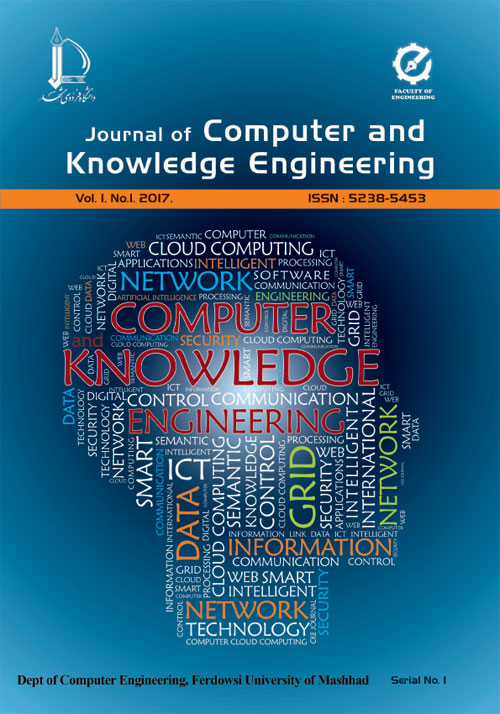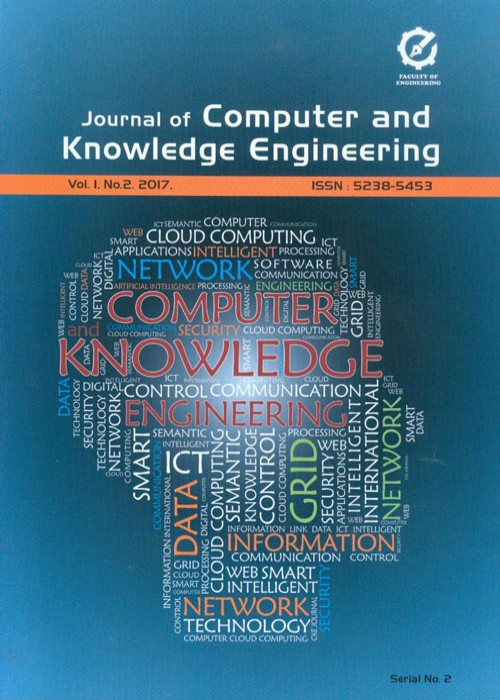فهرست مطالب

Journal of Computer and Knowledge Engineering
Volume:1 Issue: 1, Winter-Spring 2018
- تاریخ انتشار: 1396/02/27
- تعداد عناوین: 6
-
-
Pages 1-8In the emerging field of the Internet of Things (IoT), Wireless Sensor Networks (WSNs) play a key role in sensing and collecting data from the surrounding environment. In the deployment of large-scale monitoring systems in remote areas, when there is not a permanent connection with the Internet, WSNs are called upon for replication and distributed storage techniques that increase the amount of data storage within the WSN and reduce the probability of data loss. Unlike conventional network data storage, WSN-based distributed storage is constrained by the limited resources of the sensor nodes. In this paper, we propose a low-complexity distributed data replication mechanism to increase the capacity of WSN-based distributed storage, optimizing communication and decreasing energy usage. As the simulation results show, the proposed method has been able to attain acceptable responses and prolong network lifetime.Keywords: The Internet of Things, Distributed Storage, Energy Efficient
-
Pages 9-20The main idea behind social crowdsensing is to leverage social friends as crowdworkers to participate in crowdsensing tasks. A main challenge, however, is the identification and recruitment of well-suited workers. This becomes especially more challenging for large-scale online social networks with potential sparseness of the friendship network which may result in recruiting participants who are not in direct friendship relations with the requester. Such recruitment may increase the possibility of collusion among participants, thus threatening the application security and affecting data quality. In this paper, we propose a collusion-resistant worker selection method which aims to prevent the selection of colluders as suitable participants. For each participant who is considered to be selected as suitable, the proposed method is aimed to prevent any possible collusion. To do so, it determines whether the selection of a new participant may result in the formation of a colluding group among the selected participants. This has been achieved through leveraging the Frequent Itemset Mining technique and defining a set of collusion behavioral indicators. Simulation results demonstrate the efficacy of our proposed collusion prevention method in terms of selecting efficient collusion indicators and detecting the colluding groups.Keywords: worker selection, collusion, data quality
-
Pages 21-32Various applications with different requirments are rapidly developed in the smart grid. The need to provide Quality of Service (QoS) for such a communication network is inevitable. However, recently a protocol called RPL (Routing Protocol for Low Power and Lossy Network) has been standardized and is known as the main solution for last mile communication network of smart grid. In this paper, by studying the existing methods and identifying the shortcomings, we propose a customized version of RPL which we call OMC-RPL (Optimized Multi Class-RPL). Two principal advantages of the proposed method are: a holistic objective function including distinctive metrics related to QoS; and supporting the data classification which is an important requirement in this context. The main contribution of this paper is to make different objective functions proportional to the number of classes by using weighting parameters. The best values of these coefficients are determined by an optimization algorithm. OMC-RPL is evaluated from different aspects. Simulation results show that the new idea significantly decreases the end-to-end delay and increases lifetime of the nodes that have limited source of energy. It seems that OMC-RPL could be a good substitution for the available methods.Keywords: RPL, DODAG, QoS
-
Pages 33-42Nowadays, cloud computing and other distributed computing systems have been developed to support various types of workflows in applications. Due to the restrictions onthe use ofone cloud provider, the concept of multiple clouds as been proposed.Inmultipleclouds, schedulingworkflowswithlarge amounts ofdata is a well-knownNP-Hard problem. The existing scheduling algorithms have not paid attention to the data dependency issues and their importance in scheduling criteria such as time and cost. In this paper, we propose a communication-based algorithm for workflows with huge volumes of data in a multi-cloud environment. The proposed algorithm changes the definition of the Partial Critical Paths(PCP) to minimize the cost of workflow executionwhile meeting a user defined deadline.Keywords: Cloud Computing, Multi-cloud, Workflow Scheduling, Data Dependency, Communication
-
Pages 43-52In real-time task scheduling on multiprocessor systems, partitioning approach has received the attention of many researchers because of its higher least upper bound utilization of safe systems. Semi-partitioning allows some tasks to be split into subtasks and each subtask to be assigned to a different processor. Though task splitting improves the performance of systems, by counting each subtask as a separate task, it increases the effective number of tasks to be scheduled, which in turn, raises the execution overhead. This research is on semi partitioning of tasks and assigning each partition to a separate processor to be scheduled by the well-known scheduler Rate Monotonic (RM). Using our algorithm, we do not need to define release time for subtasks of a task to assure their non-concurrent execution and the number of effective tasks, in turn, is reduced. It is theoretically proven that with the proposed semi partitioning and RM scheduling algorithm, all processors may safely run their tasks according to their deadlines. Further, experimental results on 3000 randomly generated task sets indicates that not only is utilization factor boosted, but the number of broken tasks also is decreased.Keywords: Rate-Monotonic Least Splitting, Semi-Partitioning, Hard real-time, Multiprocessor Scheduling
-
Pages 53-64β-sheet topology prediction is a major unresolved problem in modern computational biology. It is a challenging intermediate step toward the protein tertiary structure prediction. Different methods have been provided to deal with the problem of determining the β-sheet topology. Here, ab-initio probability-based methods called "BetaProbe1" and "BetaProbe2" are utilized to specify the β-sheet topology. In these methods, the stability and the frequency of β-strand pairwise interaction and β-sheet conformation are spotted. To predict more frequent interactions between β-strand pairs, besides pairwise alignment probability, the probability of occurring β-strand pairwise interaction is considered to compute the score of the interactions. Furthermore, to determine the β-strand pairwise alignment probability more accurately, a dynamic programming approach is utilized. In addition, the integer programming optimization is combined with the probabilities of β-strand pairwise interactions to determine the β-sheet topology. Moreover, the β-sheet conformation probability is considered to give better chances to more observed conformations for selection. Experimental results show that BetaProbe1 and BetaProbe2 significantly outperform the most recent integer programming-based method with respect to β-sheet topology prediction.Keywords: β-sheet topology prediction, integer programming, dynamic programming, pairwise alignment


